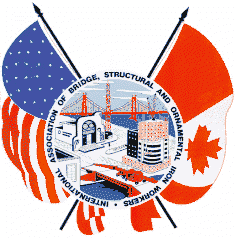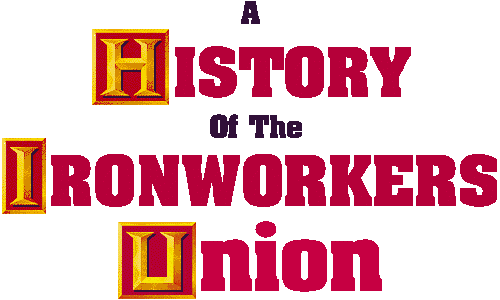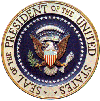|
|
|
||
|
Our History
A Union is Born
The Turbulent Years
The Conspiracy Trials
The Beginning of the
Morrin Era
The Depression and a New
Deal For Labor
World War II
Ironworkers Grow in the
1950's Part Two Part Three
John H. Lyons Jr.
Elected President
The Tradition Continues
Pathways to the 21st
Century Under The Leadership of General President Jake West
|
Part Three
HOW THE NEW DEAL
PROJECTS
HEALTH AND SAFETY DURING THE WAR Ironically, while management was attacking labor regarding time lost on strikes they were not publicizing the time lost from industrial accidents that were caused by unsafe conditions in the factories and on the work sites that management failed to correct. Secretary of Labor Francis Perkins estimated in 1943 that the sum total of production losses arising out of deaths and injuries to be 274 million worker-days lost as compared to a maximum of 13.9 million from strikes. In other words, time lost to accidents and deaths that management could have prevented was twenty times greater than time lost from strikes. In late 1943, casualties to the U. S. armed forces since Pearl Harbor were 20,104 dead, 28,229 wounded, 32,905 missing, and 23,970 imprisoned - a total of 105,205. Casualties to American workers through accidents since Pearl Harbor were 80,000 dead and 7,000,000 injured, on and off the job. These figures were from the National Safety Council. The theme of the Congress was "Stop Accidents - Speed Victory."
At the Twenty-Seventh International Convention held at the Jefferson Hotel in St. Louis Missouri from September 18th to the 23rd, 1944 General President Morrin, General Secretary John H. Lyons and General Treasurer John J. Dempsey were reelected. A resolution was passed reiterating the "No Strike" policy that was established in 1941 and a telegram was sent to the President pledging our support and notifying him of the resolution that was passed. President Morrin received the following message from the President on September 21, 1944.
ELECTION OF 1944 As the 1944 Presidential Election approached, the attacks on labor and President Roosevelt increased. In June of 1944, the Vice President of the United States, Henry A. Wallace, spoke out against what he called "American Fascists." Wallace said that "if a small but powerful group, which put money and power first and people last, have their way, the four freedoms, for which we are fighting will become empty phrases and America will find itself 'back in the good old days' when there was plenty for the few and scarcity for the many." Although the Democratic Party Platform did not have a separate labor plank in 1944, the Democrats did support some of the major demands of the American Federation of Labor. They did not agree to the specific repeal of the Smith-Connally Act, however, they did favor the Wagner Labor Act which gave workers the right to decide for themselves which union should represent them in collective bargaining. The AFL wanted the Wagner-Murray-Dingell Bill which would expand the Social Security System to cover medical costs, something that was already passed in England and Canada at that time. The Democratic Convention met at the Chicago Stadium July 19th to the21st, 1944. Although the AFL still did not believe in giving money directly to one party, they continued to follow Gompers philosophy of "Reward your friends and defeat your enemies." General President Morrin sent a letter to President Roosevelt pledging the International's support to him for a fourth term in office. Morrin received a response from President Roosevelt dated September 21, 1944. President Roosevelt won reelection in 1944 to an unprecedented fourth term in office.
ROOSEVELT DIES AND TRUMAN BECOMES PRESIDENT President Roosevelt died on April 12, 1945. Vice President Harry S. Truman assumed the office of President. Because Truman had only been Vice President for a few months, many workers did not know how he stood on labor questions. Our magazine ran story pointing out that Truman had almost a 100% voting record on labor issues. When the Pacific war ended on V J Day, August 14, 1945, the government was not prepared for peacetime. Military advisors to the president had estimated that the war against Japan would last at least two more years and result in 1.5 million more casualties. The atomic bomb changed all that. President Morrin sent out Circular Letter No. 517 on November 27, 1945 to all local unions that effective December 1, 1945, all affiliated outside erection local unions of the International Association should return to their former procedure and hold membership meetings and Executive Board meetings in accordance with the practice and custom that was in effect prior to the war emergency.
THE TAFT-HARTLEY ACT There is no doubt that Taft-Hartley was a serious blow aimed at the American Trade Union Movement. It remains today the most serious legislative bar to the organization of workers, particularly in those states where to so-called "right-to-work" laws exist, which Taft-Hartley made possible. The Act gives employers the right to conduct captive audience anti-union sessions on company time, without equal rights of unions. The National Labor Relations Board was seriously weakened by converting it into a quasi-judicial agency. The General Counsel of the Board was made independent and given broad powers to determine whether complaints would be heard. All elected labor officials - but not management - were required to file affidavits testifying that they were not members of the Communist party. Unions were permitted to negotiate for the Union-shop only after members approved in time-consuming special NLRB elections. For years unions used the "secondary boycott" in support of strikes. This took the form of refusal by members to handle or process "hot" materials - goods processed or handled elsewhere under strike conditions. While the "secondary boycott" may have been abused in some instances, it was an important basic weapon against employers seeking to maintain substandard conditions. Taft-Hartley made it illegal. Taft-Hartley also restored the use of federal injunctions in strikes, outlawed in 1932, by giving the federal government the power to determine "national emergency strikes" and to halt them for periods of up to ninety days. The law also banned the closed shop which required the employer to hire only union members. There are many other provisions of the law that are detrimental to the Labor Movement and the Ironworkers. The debate over Taft-Hartley took place between May and June of 1947. President Truman vetoed the bill but Congress passed it over his veto. A Gallup Pole showed voters opposed Taft-Hartley. This law gave many lawyers jobs, and the NLRB had to conduct some 10,000 elections in the building and construction industry that would cost the government millions of dollars.
Scroll to the top and click on
World War II and the Post War
Struggles
[Home]
[Officers]
[Upcoming
Events] |


 hen
the war began the Tennessee Valley Authority (TVA) was quickly converted
to war needs. Early in 1941 twelve large dams and a steam generation
station were under construction. Our members and other building
trades workers completed them in record time. One of the dams,
Douglas, was constructed in twelve months and nineteen days. A large
block of electrical power centers was built: new plants sprang up, and old
plants were renovated. Half of the aluminum needs during the war
came from plants supplied with electricity from the TVA. Not a
single plant stopped or slowed down for want of power. The TVA ran
munitions plants and even produced fertilizers that were sent to England
to help them grow more food.
hen
the war began the Tennessee Valley Authority (TVA) was quickly converted
to war needs. Early in 1941 twelve large dams and a steam generation
station were under construction. Our members and other building
trades workers completed them in record time. One of the dams,
Douglas, was constructed in twelve months and nineteen days. A large
block of electrical power centers was built: new plants sprang up, and old
plants were renovated. Half of the aluminum needs during the war
came from plants supplied with electricity from the TVA. Not a
single plant stopped or slowed down for want of power. The TVA ran
munitions plants and even produced fertilizers that were sent to England
to help them grow more food. The
White House
The
White House